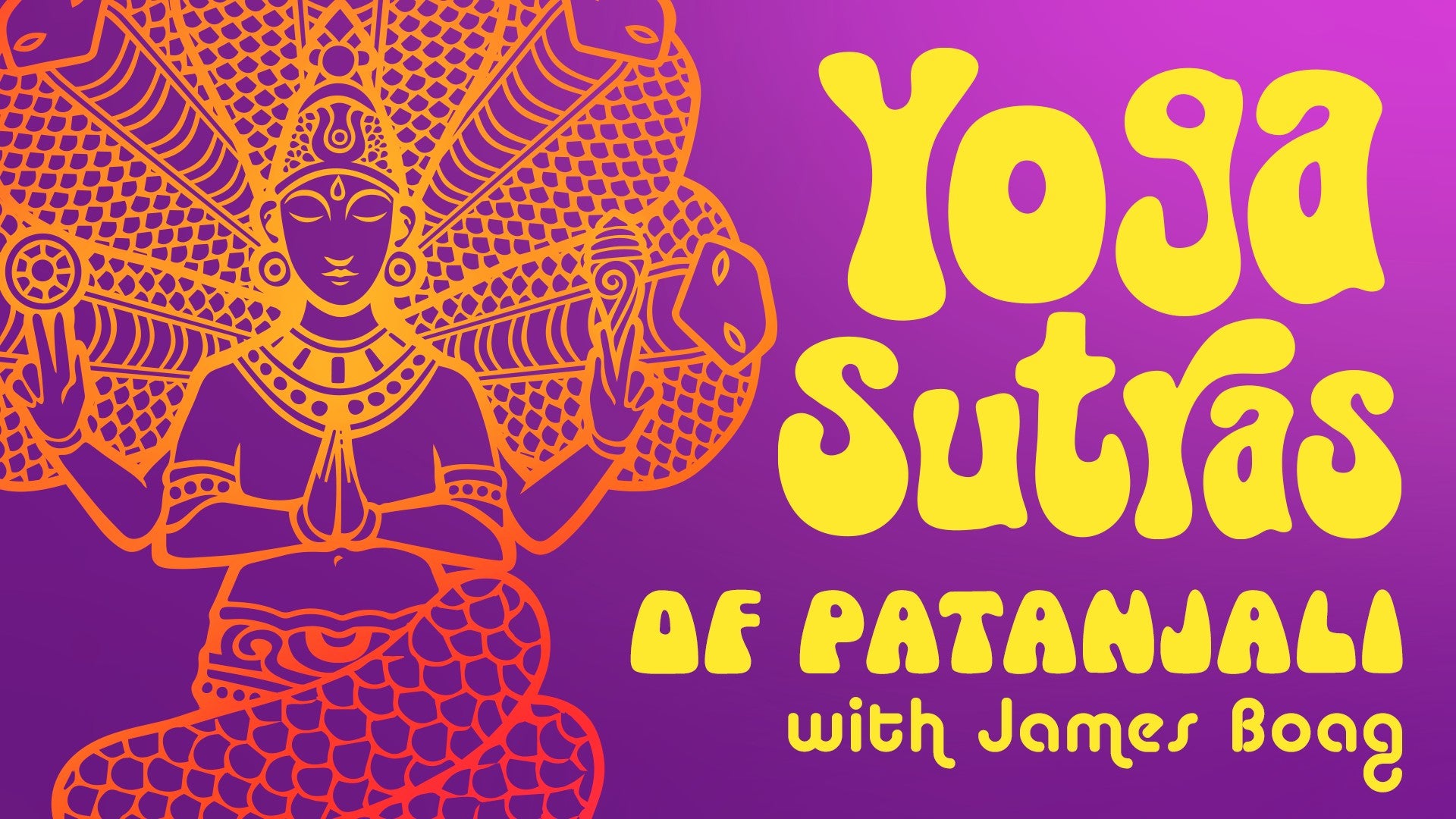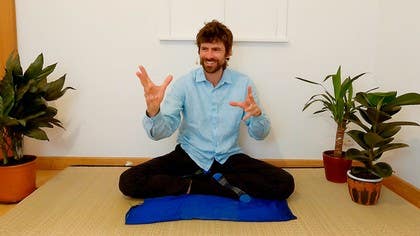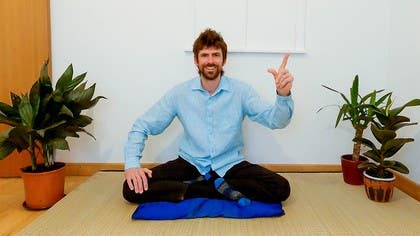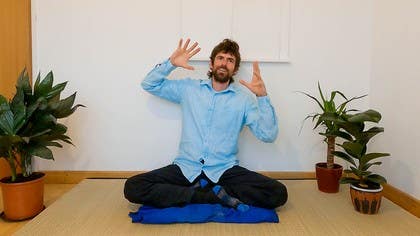Description
About This Video
Transcript
Read Full Transcript
So, having given us this vast range of possibilities, which we can use for subtle internal meditative practices, in the 40th Sutra, Patanjali then says, what's the effect of that? He says, paramanu, paramatvantosya vashi karahan, so eventually the yogi's awareness is able to accede to this point or this state in which we have awareness, cognizance, understanding from paramanu, from the subatomic, smallest of the smallest level, paramatvantosya, to the greater than the greatest, all vastness, universal level. So basically, remember when Patanjali is laying everything out in the yoga sutra, he's doing in a very comprehensive way. So these teachings apply wherever we are, but they also apply for that yogin who's making it all the way to complete self-realization. So Patanjali says, when our chitta, when the realm of our awareness becomes very prasadana, clarified, as we cultivate this subtla, subtla state of integrated awareness, eventually from the subtlest of the subtlest, the greatest of the greatest, the yoga is able to attune to all that.
The yoga is able to experience the absolute pure essence of existence at every level. So this means that in order to really get to that point, we have to go beyond our day-to-day perceptions. And this is one of the reasons why in yoga, those subtle, steady, internal practices are a significant part of practice. Yes, there's so many ways we can practice in our day-to-day life. As Patanjali already told us, if whenever we find ourselves in an agreeable situation, we act in a friendly way, whenever we find ourselves in a difficult situation, we are compassionate, whenever we find ourselves in a wonderful situation, we let it lift us up whenever we encounter terrible things, we're able to stay steady, we know we're in yoga.
But another way we know we're in yoga is when we see the essential reality of everything. So that's a barometer, a guide, that we can use to orient our practice. It helps guard against the valley of false enlightenment, and we see this a lot in the yoga teachings. Patanjali lays things out in such a way that it makes it harder for us to fall into that trap of getting carried away with our immediate or short-term accomplishments. We've got that orientation that reminds us, oh yeah, there's a bigger picture here.
So now from here until the end of the chapter, Patanjali is really going to tune in more to the mechanics of meditation. Now as we work from gross to sottal, our awareness refines, and how that basically clarifies this lens of our awareness. So the lens or the filters through which we perceive reality, how they get cleansed and purified through the practice that moves from gross to sottal. So 41 he says, So now Patanjali introduces this state of awareness called Sam apatihi. Now you may notice that sam apatihi sounds rather like samadhi, and it is.
So samadhi, the state of even integrated awareness, sam apatihi, pat is the verb to fall. So sam apatihi, it's like when the awareness falls in well to this subtle state. And kshina vrittihi, so the vrittis, the movements of the awareness, when they have become kshina, when they're no longer so disturbing, when they're no longer having such a distorting influence, so then it's like the awareness becomes like a transparent gem or a crystal. So if for example, we have a clear pure gemstone that's transparent, and I put it in front of my face, and on the other side of the gem, there is for example, a blue object, I will see the blueness as it is, because the clear crystal will not distort it, it will allow me to see it as it is. And Patanjali says, in the state of sam apatihi, when our awareness becomes this subtle, this clarified, this refined, then the lens of our internal awareness becomes like that pure, clear, transparent crystal.
And this relates to whatever is placed before it, whether that is the grahitre, the one that is grasping, in other words, the seer or the subject, whether it's that which is grasped, that which is seen, the object, or the means of seeing. So in this subtle state of awareness, we're seeing things as they are, but we are still seeing things as a subject, seeing an object and being aware of a means of seeing that is linking those two things. Ultimately yoga is oneness, yeah, so in this sam apati state, the still subject object and the means that allows the subject to see the object, but we're able to see those three different aspects clearly, as if seen through a pure lens, rather than a lens that is dusty or has a particular type of filter or tint on it. We're seeing things as they are, but we're still seeing the differentiation between the subject, the object and the means of seeing. So now potentially starts to define the different stages of sam apatihi, so basic sam apatihi, we're seeing clearly, subject, object, means of seeing, sa vitarka sam apatihi, nir vitarka sam apatihi, sa vichara sam apatihi, nir vichara sam apatihi, four gradations or four varieties of sam apati state of awareness are now defined.
Maybe you remember back in the 17th sutra, potentially said, as we move from gross to subtle, then the quality of meditative awareness moves through these different stages, vitarka vichara nandas mitaru panugamat sam bhagya taha. So first, sa vitarka with vitarka. So vitarka is like that sense of curiosity and inquiry. So here potentially says in the 42nd, shab tatra there in that sam apati state, when there is shab tarta jnana vikal paihi, so shab da means the word or the sound, artha is the meaning and jnana what is known or signified by that word and that meaning. So in this state of sa vitarka sam apatihi, the word, the meaning and the knowledge that ensues the idea associated with that word and its meaning, those three things are all still mixed up.
So for example, if I am meditating on an object, there is the object as it is, there is the word that denotes the object and there are all the ideas associated with the object. So for example, if I was meditating, let's just say for example, I'm going to meditate on the pen. So there is pen, a word, there is pen, the object that the word denotes, but then there is the concept or the idea of a pen. So I am meditating on pen and penness and this object, but this object, the idea of pen, the associations of pen, they're all still kind of mixed up. So this is sa vitarka sam apatihi.
I'm getting focused on the pen, but this focus involves ideas to do with pen, associations to do with pen. If for example, I am a person who uses a pen in my day to day life, I might have other associations that are creeping into that, to tinge that perception. Then what happens? In 1843, smriti pari shuddh haus farupo shunye vartamatra nirbhasa nirvitarka. So sa vitarka is when I've still got these ideas, these concepts, these associations.
So instead of being able to see the pure essence of the pen, I'm focused on the pen or whatever object is I'm focusing on, but I'm still influenced. My perception is still tinted, flavoured, coloured by the ideas and the resonance of the word that is denoting it, but in the nirvitarka sam apatihi, then there is no longer that mixture and I just see the essence of the object. I'm just perceiving the essence of the pen in its pure penness, devoid of all the associations and ideas associated with the pen that I might previously have had. Then what happens next? Ei tayeva sa vichara nirvichara chas sug shma vishaya av yakya ta.
Same differentiation stands for vichara, sa vichara an nirvichara sam apatihi. So pen is a relatively gross object. If for example, the object of my meditation is, let's just take a classic meditation example, the experience of the breath in my body. So I'm focusing on the breath, here I am and I'm watching the breath, I'm experiencing the breath, I'm feeling the breath, I'm relishing the breath. My mind goes somewhere else and I come back and I'm on the breath and I'm getting more and more into the breath until only the breath remains.
But I'm still aware, I'm concentrating on the breath. I'm experiencing the breath, I'm noticing the breath and I'm noticing how it's affecting my physical body. Maybe I'm noticing how it's affecting my energy. I might be noticing how it's affecting the peacefulness or serenity of my mental sphere. So this is a kind of savi tarka, sam apatihi.
I'm on the breath but there are all these different aspects of the breath that are involved in my current experience. Now imagine that I'm no longer so conscious of I am here watching the breath, experiencing the breath. It's just like I'm absorbed in the experience of breathing. I'm experiencing it without that filter. I'm not experiencing the differentiation between me, the subject who is watching and the object of the breath moving through me.
These things are coming closer and closer. Now imagine that as that is maintained a subtler realm of experience opens up. So here I am meditating on the breath and initially I'm concentrating on the breath. I'm noticing the breath expanding my body in this way and that way, drawing back in in this way and that way. I'm feeling the effects in my body this way and that way.
But now I access this subtler realm of experience of the breath that wouldn't ordinarily be available. And now I'm entering the Savicara realm of meditative exploration. So this is a subtler realm of inquiry that is only able to be gained access to once I've passed through that grosser level of inquiry because in order to access the Savicara realm it's like the powers of my senses and the powers of my awareness, they have to tune in. It's like they become a finer instrument. So just like for example, today I was doing some gardening.
I can use my hands to lift up a big bag of compost and throw it on the ground. I can also use my hands to pick a tiny seed and several tiny seeds and then sort them out and place them very carefully in some compost I have prepared in a pot or a tray. Same hand, but the gross action, it's very capable of doing that, but it's a different type of application of that power that allows me to access the subtler capacity to place the tiny little seed in the seed drill I've prepared for it. Similarly with our internal awareness. When I'm using my sense powers to focus at the relatively gross level on the physical phenomenological experience of the breath, relatively speaking, though that is subtle compared to using my sense powers to engage with the external realm, it's still relatively speaking gross.
When I maintain that subtle internal flow and the awareness refines and refines and refines then the subtler realms of the breathing experience open up to me. And as my awareness tunes in more and more to that, I start to experience a whole realm of subtler experience. Then what effect does this have on my awareness? In order to maintain that subtle flow of meditative presence, it's like I'm fine-tuning these instruments of my perception and my experience. And as I do that, it gives me greater access to this subtler plane and what is the effect of this?
So then what happens? What this then enables is for the yogin's awareness to accede to that point which is called Alinga. So linga means a sign. So Alinga is that level of consciousness where things have not yet taken on a phenomenological or manifest form. So basically the recipe potentially is laying out here is when we keep practicing channeling our awareness from gross to subtle, as we tune in more and more subtly, eventually we can bring our awareness so it is sitting, steady, alert, receptive at that frequency that is kind of equivalent to the first sprouting of infinite cosmic potential.
And this is why we're able to experience from the subatomic subtlest of the subtlest, smallest of the smallest, to the vastest of the vastest. TÄ쳌 eva sabÄ«ja samÄ쳌dhi and all of these levels of subtle experience, these can all proceed from samÄ쳌dhi with a seed, with a support. So going back to sutras 17 and 18 when potentially said sampragya to samÄ쳌dhi, the samÄ쳌dhi with a support, we give ourselves that object to focus on and by working with the object we can come to that place where our awareness is tuned to the level of that first sprouting of cosmic intelligence. Then nÄ« vichÄ쳌ra vÄ쳌ishÄ쳌rÄ쳌dhi ad-tyÄ쳌dma prasÄ쳌rahÄ쳌. And what's the consequence of that?
When we're able to let our awareness sit there, then the effect is that our awareness starts to become accustomed to our real essential soul level spiritual reality. But when we're able to dive in and stay submerged or immersed, seated in that level of experience, this has this tremendously clarifying effect on the levels of our awareness. RÄ쳌tambara tatrÄ쳌paryÄ쳌. To the degree that our deep intuitive wisdom becomes attuned to rutta, to the level of cosmic vibration, cosmic truth, the rhythm of the universe, the music of the spheres, that fullness is coursing through us and we're able to notice it, apprehend it, be at one with it. And what happens here, Å?rutÄ쳌numÄ쳌na prajñÄ쳌bhyÄ쳌ma nÄ« vichÄ쳌ra vishÄ쳌rata dvÄ쳌t.
Here potentially says, and this type of experience is beyond what one can hear about or what can be inferred. So remember right at the beginning of the chapter potentially laid out what are the prÄ쳌manas, the means of valid knowledge that are accepted in yoga. And he said prajñaká¹£a, direct perception, anumÄ쳌na, inference and agama, reliable testimony or scriptural authority. And here potentially says this level of experience, when you bring your awareness into that sautless state of samÄ쳌dhi, this, you can't hear about this, it's beyond words. This is a realm completely beyond that which can be denoted or described with language.
And so this type of experience, we have to have it for ourselves with our direct perception. So along the way, words and support of our friends and colleagues and teachers and guides, excuse me, and inference, they can help us learn. But when it comes to this sautless level of inquiry, this sautless level of experience, there's no substitute for the direct perception. That's the only way you can really know this. TÄ쳌dja samskarau nya samskarau pratibandi.
Now when one exceeds to this place, what then happens? This is the 50th sutra and this is a very important sutra, even if we don't get to this super subtle state today or even in this lifetime, because what potentially says is tÄ쳌djÄ쳌ha, what is born from this level of experience, what is born from this subtle type of experience, samskarauha, nya samskarauha pratibandi. So the Sanskrit word samskarau, it's the same word as samskrita, the language, samskrita, Sanskrit means well-made, well-done. A samskarau is a pattern or a habit that is well-established, that is well-made. It's a well-carved groove of our habits, you might say.
And what potentially says here in the 50th sutra, this is very very beautiful and very very helpful to remember. The experiences born from this type of integration are very powerful. And the samskaras, the well-made impressions that grow from, that result from this type of internal subtle experience, they're very very powerful and they can block, they can get in the way, they can disarm other types of samskaras. So this is the whole idea of how yogic practice and how meditation practices can rewire our brain, can recalibrate the ways that we experience reality. Yoga is very practical, it recognises that everything that we experience, it leaves an impression but often our impressions, we experience them in a rather partial way.
It's not that we're fully there experiencing that thing. Classic example, there are some habits we have that part of ourselves loves doing that but another part of ourselves really regrets doing it later. This is a partial habit, when we enter into the realm of samadhi by definition it is a whole system, holistic in the pure sense of the word experience, we're fully there. And so when we experience samadhi, the impression washes into every cell, is imprinted into our cohesive whole being and this has an almost like superpower effect. In significant contradistinction to any other type of impression, the impression of samadhi affects the whole system as one and when we have these whole system experiences, then those partial experiences, they lose so much of their grip, so much of their power.
Sometimes the habits, the samskaras, the tendencies that we develop, we develop them in reaction, as a compensation. So sometimes for example, certain habits that we develop and take on, we do them as a compensation to make up for some difficult situation we've experienced to, as a coping mechanism in some difficult situation, but then get set in motion a habit. Now this habit, let's say we were there in a very difficult dark situation, the thing we latched onto, the habit we developed, was like a little guiding star, like a little torch. But when the full midday sun of samadhi arises effulgent in the sky, in the firmament of our being and floods every cell of us with that glorious sunlight, what happens to the little lamp of our little torch? It is obliterated, it is dissolved.
It's no longer required and the system recognises that and so it's able to then let go of those partial limited compensatory reactive patterns. Also the experiences born of samadhi, there's a saying from Shankarachari, one of his great teachers in the Indian tradition, he says that just a few moments of samadhi, they can ash mountains of previously established residual impressions. How is that? Because so many of these previously established residual impressions, they were pushing us to keep exploring until we can actually experience what we're deep down longing for, which is that experience of wholeness. So the sooner we invite wholeness, the quicker we can work through all these partial habits.
So as the system gets exposed to and a bit more accustomed to the richness of samadhi, the richness of wholeness, then those partial habits, they lose their grip. Those shackling ways, they're no longer able to bind us so strongly and we can eventually dissolve the bondage of those limiting ways. And there's also the idea encoded here that samadhi is a self-propelling practice. It's a self-validating effort. When we make that effort to invite that harmony, to invite that balance, it is its own reward.
And so like any new habit, the initial effort can be quite a struggle. But the promise is that when we make that effort to invite ourselves into that subtler, more cohesive state of awareness, it will bring deeper serenity. It will help us meet the continuing challenges of life that little bit more calmly. And we'll have proved to ourselves that we can navigate those turbulent times and we will gain greater faith and confidence in our own capacity for steadiness to see us through these different challenges. And this goes back to the 20th sutra of shaddha, self-trust, virya, that heroic valor, smriti, memory and samadhi.
As we cultivate samadhi, as we experience samadhi, we build up a memory bank of how worthwhile the effort to invite that state of awareness is. And as we do that, it bolsters our self-trust and strengthens and fortifies our courage. So samadhi, worth the effort. And then potentially culminates the chapter by saying, tasyÄ쳌 piá¹?irÅ«á¸쳌i saravaá¹?irÅ«á¸쳌a nirbiá¹?á¹£a samadhi. So let's say, for example, we have been meditating on an object and that object has allowed our awareness to travel to that state of very, very subtle integrated awareness, to the degree that the whole system has been flooded with the experience of samadhi.
Let's say then, the object we were focusing on, it's played its part, it served its purpose, it falls away, and then rise up these residual tendencies, these residual patterns that want to be cleansed, that need to be harmonized, if we're going to actually be able to experience samadhi in this sustainable way. And then Bhattani says, once that's happened, when that internal process of the new imprint of integration dissolving those old partialities, when that process continues, eventually it comes a point where even the process of dissolving the old limitations, that too can fall away. And then it is samadhi without a seed. We're able to experience that samadhi without the need for that initial support. And also there's the idea that we come to a state of awareness so purified, so clarified, so clear, that now it's no longer necessary for us to keep planting the seeds of more continued karma.
We can actually experience pure consciousness right here, operate from there. And so move through life towards ultimate liberation without accruing more bondage. So this is the ultimate state of it all. This is a very quick summary. There's a lot of technical information encoded here in a short space of sutras.
This is what Patanjali does. But I think it's really helpful to be reminded of the completeness of the vision of chapter one when we start to explore chapter two in greater detail. And especially the primacy of samadhi is that this state of integrated balanced awareness, this is going to be the, let's say, orientation for our practice. And it's also going to be the kind of engine or propeller of our practice. As we keep cultivating samadhi, it will be self-generative, it will have this renewing and recalibrating and rewiring effect in the circuit and system of our being.
And this is one way that we will know if our practice is actually helping us because we will feel that little bit more balance, cohesion and integration. And if at this point we're already established in yoga, we don't need to continue, Patanjali is very efficient. So we come to the end of chapter one and we think, yeah, that's it, job's done. No need to continue, but Patanjali is a great humanitarian. And for those of us for whom that is not the case, most of us as human beings, he has laid out the wonderfully practical elucidations and elaborations of chapter two, which is where we'll continue.
Yoga Sutras of Patanjali: Whistle Stop Tour of Chapter One
Comments

You need to be a subscriber to post a comment.
Please Log In or Create an Account to start your free trial.












